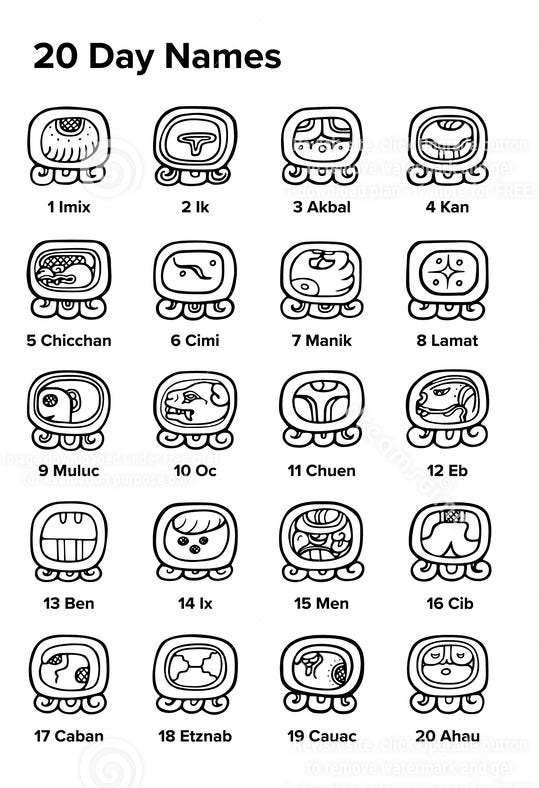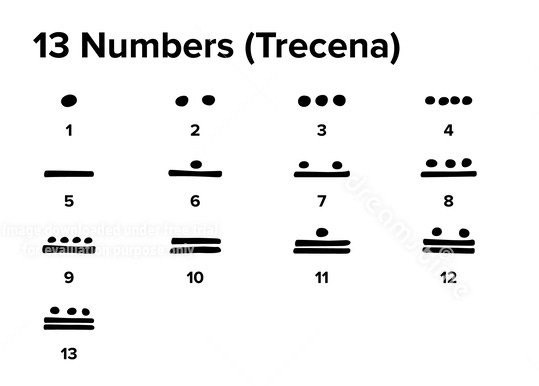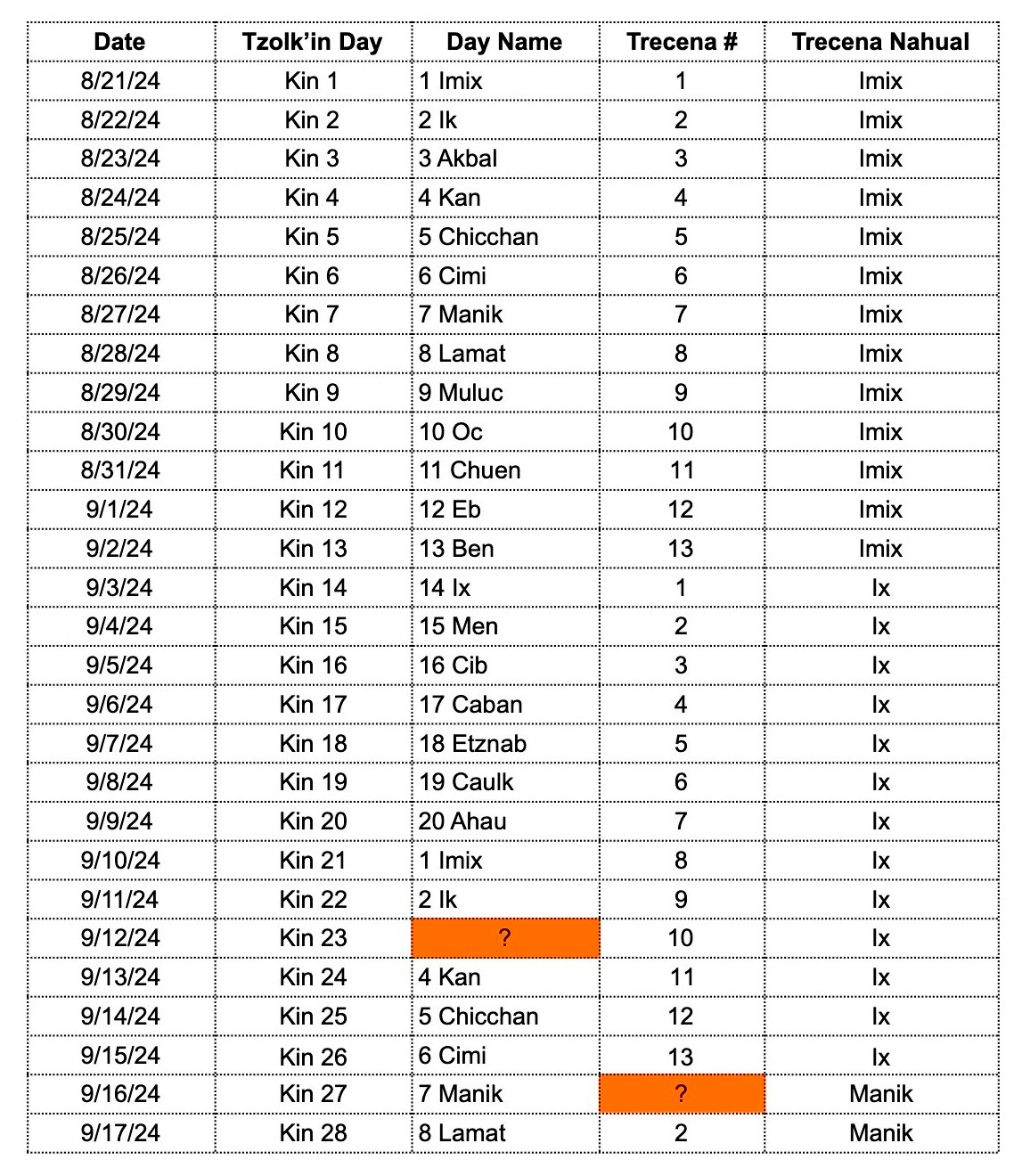Men Speak | Sol® Ser•Men #131 — Chapter 2

Kenneth's Original Title:
Solar Sermon #224
Published Title:
a coded eagle transmission ... . ...
Sol / sun (in spanish) +
Ser / to be (verb) in Spanish +
Men / Eagle (in Kaqchikel language) +
12/29/24 is Kin #131 in the Mayan Tzolk'in Calendar =
Sol® Ser•Men #131
Little People Comment:
"Solar Sermon, Ken?
...or Mer•Man Ser•Men?"
Though not necessary, i do invite you to read Chapter 1 prior to this, as doing so provides a baseline of scaffolding for the eagle eye view of this article series. That said, this chapter is whole and complete independent of the series.
Chapter 2 — The Tzolk'in Calendar
The subject matter of this article is the 'Sacred Calendar' known as the Tzolk'in, part of a larger calendrical system, often associated specifically with the Mayas though was used by most, if not all, ancient cultures of Mesoamerica. So says a variety of sources i've read.
To begin, i'm called to acknowledge, i am by no means an authority on the Maya Calendar(s) or Maya timekeeping, nor have i trained with or been initiated by a Maya Daykeeper (yet) – i am simply a student sharing his learnings.
This December, i've found myself in an unexpectedly passionate and immersive exploration of Maya timekeeping, despite years of keeping a distance from various forms of 'reference and mapping systems'. As is often the case, i'm guided and moved to where i am to study/explore, so as to support the process that i am being moved and birthed through.
Initially, i did not know why the interest and curiosity, in fact, i still don't. i'm very simply following the inspiration, prompts, and doing the research as guided...one things leads to the next, and the next...many know this way.
The more i study and grasp the mechanics of the Maya calendrical system the more awed i am by eloquence and beauty of the design. For me, Maya timekeeping provides an intriguing and awe inspiring glimpse into the Divine architect/ure of nature and the inherent natural rhythm and cycles of life; through a lens that is resonant with my unique makeup—and honestly, it's refreshing.
An important note, before we drop in.
Because i know who I AM—beginningless, endless, and eternal—this is but one (personally resonant) angle of confirmation. An enjoyable and interesting and [countless adjectives] body of knowledge/system that serves to affirm and color my direct lived experience and what i already know to be the true. Maya timekeeping is/has been a critical ingredient in this Eagle/Eagle Clan initiation and for that and much else, i'm very grateful.
i honor, respect, and appreciate the many angles and angels of perspective—and the countless facets through which one may glimpse and connect with essence. For example, the little people allude to the oceanic mythopoetic lens in their comment, "MerMan SerMen", which has been a HUGE archetypical architecture for me.
God making God ooo and ahh!
One of the original Maya calendars—and not just used by the Mayas, but by most, if not all ancient cultures of Mesoamerica—is the CholQ'ij (Kiche language) or more commonly called the Tzolk'in (Yucatecan languages).
"[It is a] “ritual almanac” of 260 days, comprised of 20 symbolic day signs and a series of 13 numbers (13 x 20 = 260)¹, "very much in the same way our months consist of the association of 7 week days (Monday to Sunday) and 28, 29, 30 or 31 numerals (for example Friday the 13th which is the 13th day of the month and the 5th day of the week).
Each [calendar] day is uniquely designated by the combination “coefficient/day-name”, and not until every single one of the numbers 1 through 13 had been attached to every one of the 20-day names was the cycle complete. It would take 260 solar days to complete...[and] a particular combination will not recur until 260 days have elapsed."²
The 20 day names are unique and each has an associated glyph called a Nahual/Nawal, which represents a spirit animal or energetic archetype. The 13-day period is called a Trecena and to reiterate there are 20 x 13-day Trecena Periods, each one of those 20 x 13-day periods having an associated Nahual.
If you're confused, that's ok, i was too—and i'm going to explain. Take a look at this graphic below of the 20 Day Names and 13 numbers/days in a Trecena Period. The number in front of each day sign simply refers to the day number, which is its position in the 20 day sequence. Day 2 comes before day 3, etc.
So, let's make this practical. The current 260 day cycle we are in began on 8/21/24. On that day, referred to as "Kin 1" or "Day 1", the day sign/name was 1 Imix, which corresponds to the first of twenty Nahual's from the list above, see?
Further, the Trecena number (or coefficient) is 1, as 8/21/24, Kin 1, was also the first day of the first 13-day Trecena period. Each 13-day Trecena is ruled by the same Nahual. The 13-days spanning from 8/21 - 9/2 were all ruled by the same Trecena Nahual, in this case Imix/Crocodile, which is the first of twenty nahuals that sequence thru the 20 x 13 Trecena Periods.
i imagine most who are reading this may be confused (hopefully you're not), but if you are, let's switch to a more visual approach. This will definitely make the material easier to comprehend. I love making spreadsheets, so i seized the opportunity to do so!
The spreadsheet below has 5 colums:
the date (in typical Gregorian fashion)
Tzolk'in Day (there's 260 of them)
Day Name (there's 20 of them, see above)
Trecena # (there's 13 of them, see above)
Trecena Nahual (the same 20 as the Day Sign Nahual's, but they sequence in a different order than the day name sequence).
As quoted at the start of this chapter, "each [calendar] day is uniquely designated by the combination “coefficient/day-name” – with 'coefficient' referring to the Trecena number.
8/21/24: 1 Imix (ruled by the Trecena Nahual of Imix)
8/26/24: 6 Cimi (ruled by the Trecena Nahual of Imix)
8/30/24: 10 Oc (ruled by the Trecena Nahual of Imix)
9/4/24: 2 Men (ruled by the Trecena Nahual of Ix)
9/10/24: 8 Imix (ruled by the Trecena Nahual of Ix)
Even though 8/21 and 9/10 are both the day sign of Imix, 8/21 was day #1 and was ruled by the Trecena Nahual of Imix, while 9/10 was day #8 and was ruled by the Trecena Nahaul of Ix. This is just one facet of the detail and nuance of variation that is available for exploration and contemplation as one deepens into the mechanics of this calendrical system.
Ok, it's your turn...
Q1: What was the day sign for 9/12?
Q2: ...and what was the trecena # for 9/16?
Bonus: What's the day sign, trecena # and governing Trecena Nahaul for Kin 29?
.
.
.
A1: 3 Akbal
A2: 1
A3: 9 Muluc (or just Muluc), 3, Manik
Note: If you were to look up the info for 9/18/24 (Kin 29) in an app or site, you would see: '3 Muluc'. While the day sign is 9 Muluc (the 9th of 20 day names from the Day Name graphic above), the trecena day number is 3. As shared, it is the trecena day number that precedes the day sign; hence '3 Muluc', not '9 Muluc'
Notice the day sign sequences from 1-20 and then starts again at 1? That's the turning of the day-sign wheel, as it's cyclical.
Also notice the Trecena # sequences from 1-13 and then starts again at 1? Again, a wheel, with a cycle...and that each 13-day cycle has a single ruling Nahual?
The first 13-day Trecena period is ruled by the first trecena nahual, Imix. When the second 13-day period began it shifted to Ix; the third, Manik; and so on. The order of appearance/sequence of the governing trecena nahual's is different than the order of appearance/sequence of day sign nahual's.
This would be where i would share that sequence, but i won't. You can research it yourself and/or you're welcome to email me if you'd like me to share with you.
Fast forward (rewind now) to, 12/29/24 (the date i began writing) has a trecena # (1) and day sign (Chuen/monkey)—and ruling Trecena Nahual (Chuen/monkey) for the 13-day period it falls within.
12/29/24 is special too, as it's 1 of 20 days in the 260-day cycle when both the day sign and the Trecena sign are the same, both in this case are Monkey. i read somewhere that to the Maya, the monkey represents the weaver, the weaver of time...and here i am weaving with words about time, how apropos.
As an aside, for those curious, the 20 days of the calendar cycle when the day sign/Trecena sign are the same, all fall on the first day of each of the 20 x 13-day Trecena Periods. You can see this in my spreadsheet above as happened on 8/21, 9/3 and 9/16; dates which were precisely 13 days apart.
On the subject, here's another thread for the weaving.
One of my nicknames as a toddler was "Monkey Boy" because i loved to climb on everything. Today an older Monkey Man is writing on 1-Chuen/monkey (in the Trecena period of Chuen/monkey) about timekeeping and how that supports the expression of—and confirms his path of embodying—the essence of his being, which in this maya calendrical context is that of 1-Men/Tzik'in, which i'll expand upon further in the next chapter.
If you're interested to translate your Gregorian birth date into the Tzolk'in calendar to determine your "Birth Kin" and to see your trecena-number/period sign and day-sign, here is a site to do that.
My innerstanding of the Mayan Calendar/timekeeping is rather "structural" at the moment as i continue to drink in the warmth and richness of the poetic substance that fills the structural/mechanical framework.
Regardless my studies have served to harvest unique gems of insight, some of which i'm sharing here, at least peripherally as there is nuance i yet have language for. Further, there's seemingly infinite layers of depth to the system; and discoveries to be made—and i've literally only just shared an elementary introduction here, albeit a rather comprehensive one.
...and this may be as far as i go with my study and sharing, time shall tell.
The subject matter of Maya Calendar(s)/timekeeping (and the system itself) is quite layered and given this there's much mis-information, literally, a world of maya (distortions and illusions) and info simply lost in translation.
Like anything, do your homework to develop your own felt-sense of the landscape of Maya timekeeping and/or consult with someone you've determined is credible and deserving of your trust.
i've done my best to keep this introduction to the Tzolk'in as simple as possible, albeit with a definite technical flare, inspired by my engineering background.
...and that's a wrap on Chapter 2! Much was shared here and it may take a few reads to grasp the material, if that's of interest to you...and if not, so be it!
Regardless, i suggest you burn some sage; close your eyes; breathe, and move your body to digest and integrate; who knows what the medicine is for you...? I'd love to know though, please do leave a comment and share!
Below is a track for you to listen to for integration.
P.S. – in the next chapter we'll do a case study, on me! i'll be sharing with you my personal Birth Kin and connection to the Eagle totem 🦅
P.P.S – if inspired, you're absolutely welcome to share this with soul kin.




